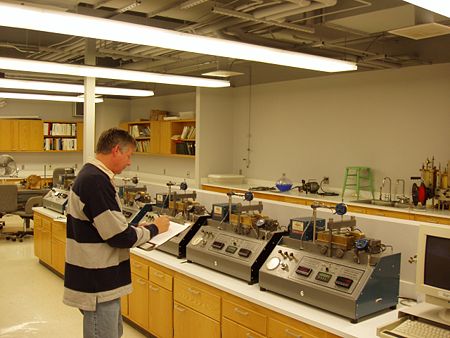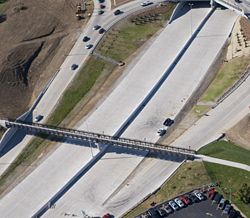Other Aspects of Pavement Design
Alternate and Optional Pavement
Refer to EPG 242 Optional and Alternate Pavement Designs.
Approaches and Driveways
Refer to EPG 233.2.10 Driveway and Approach Pavement Design Criteria.
Asphalt Over Rubblized Pavement
Refer to EPG 450.8 Asphalt Over Rubblized Pavement.
Shoulder Surface

Paved shoulders and aggregate stabilized shoulders provide a secure surface to accommodate vehicles for emergencies and other uses. Paved shoulders are an integral part of the pavement structure and are considered as part of the pavement design configuration. See Shoulder Width for additional information
| Additional Information |
| EPG 350 Design for Bases and Aggregate Surfaces |
Shoulders on urban roadways with access control (major or minor) are to be paved. In no case will a paved or aggregate surface be used directly behind a mountable curb along the outer edge of a roadway. A curb and gutter will only be used with a posted speed less than 50 mph.
Currently shoulder designs for new roadway construction are categorized as Type A1, A2 and A3. The Type A1, A2 and A3 designations should not be used when adding shoulders to existing pavements, (see EPG 231.4.3 Shoulder Widening Projects).
Type A1 shoulder design is comprised of asphalt or concrete on a prepared aggregate subgrade placed the same thickness as the mainline pavement. This shoulder type is to be used sparingly, in instances that can be justified such as where there is an imminent need for use of the shoulder as a lane.
Type A2 shoulder design consists of asphalt, concrete or roller compacted concrete on a prepared aggregate subgrade with the final surface placed 5 ¾ in. thick. Type A2 shoulders are used on all interstate routes and for major roadways with significant traffic.
Type A3 shoulder design consists of asphalt, concrete, or roller compacted concrete on a prepared aggregate subgrade with the final surface placed either 3 ¾ in. thick (asphalt) or 4 in. thick (concrete or roller compacted concrete). This shoulder type is used on major routes (non-interstate only) with relatively lower traffic volumes and on minor routes where a paved shoulder will be provided.
For new construction, a paved shoulder is provided on major routes, the full thickness of the travel way pavement should be extended laterally to a longitudinal joint either 1 ft. or 2 ft. outside the travel way. This widening is to extend 2 ft. for interstate and 1 ft. for all other locations. In instances where short segments of pavement are placed, butted at each end by pavement that is not widened, approval may be obtained to omit the widening.
For resurfacing projects on roadways with shoulders 4 feet or narrower, when shoulder improvements are also anticipated as part of the scope of work, the same asphalt surface mix used on the travelway should be extended the entire shoulder width. This will allow for a single monolithic pavement operation for the shoulder, reducing additional lane drops and construction time. All shoulders wider than 4 feet should have the same asphalt surface mix used on the travelway extended onto the shoulder a minimum of 18 inches. An alternate mix type may be specified beyond 18 inches when the shoulder is wider than 4 feet. This will provide a continuous surface mix for placing rumble strips/stripes. (See EPG 626 Rumble Strips.)
Ramp shoulders should be consistent with the mainline. For ramps with integral curbs, the shoulder material and thickness will be specified in the pavement thickness determination.
Minor road shoulders should be aggregate stabilized except when maintenance or safety concerns (e.g., edge drop off, high run-off road occurrence) justify an alternate treatment. When conditions warrant, a 1 or 2 ft. lateral extension of the mainline pavement should be considered as an initial option. If paving the remaining width of shoulder is justified, the shoulder should consist of the Type A3 shoulder design.
Soil Characteristics

Since the performance and durability of pavement primarily depends upon the support provided by the underlying subgrade materials, it might be said that soil is the most important of all materials used in highway construction. The achievement of an adequate pavement structure requires a close coordination of soil survey, design, and construction to produce the best possible combination of the most economically available materials. The engineering properties of soil, probably more than any other factor, except drainage, influence the service and performance of all types of roads.
Soil Surveys. In order that all pertinent soils information be made available for proper design use, soil surveys and cut classification investigations are made by district soils and geology technologists for most projects. Basic soils information which can easily be understood and used by those who have not specialized in soil science is furnished by the Construction and Materials Division.
Specific recommendations for cut, fill, and bridge spill fill slopes are contained in soil survey reports. For those projects on which soil survey reports have not been made, such reports with specific slope recommendations are requested from the district construction and materials engineer.
Effects of Soils on Pavement Designs. For flexible types of pavement, bases and subbases provide uniformity of support and strength and serve to distribute the load to the underlying soil over an area greater than the contact area of the tire. The weaker or more unstable the underlying soil, the greater the required area of load distribution and, consequently, the greater the required pavement thickness. For rigid pavements, bases provide uniformity of support and a means of preventing pumping.
Unsuitable Soils. Unsuitable soils are those which have unstable, non-uniform or otherwise undesirable subgrade support characteristics. Highly plastic clays may have detrimental volume change characteristics (shrink-swell) from removal of overburden or changes in moisture content. This may be a particular problem when encountered in pockets, in varying thicknesses and when transitioning from cuts to fills. Silts are susceptible to rutting and pumping if compacted wet or in proximity to available moisture and may remain susceptible to pumping and frost heave from capillary action after paving. Particular problem materials include the "underclays" found beneath coal beds in Pennsylvanian age strata and gleys or gumbotils often found associated with glacial tills. Differential settlement, rutting and fatigue cracking in pavements is common when these materials are left in the subgrade.
The minimum standard treatment of clay soils of moderate plasticity and average volume change potential includes cut compaction and compaction at moisture contents in excess of the optimum in the upper part of the subgrade. Silty soils should be compacted at moisture contents below the optimum. The standard specifications provide for both these measures.
Consideration may be given to various forms of subgrade stabilization using chemical (lime, flyash, lime kiln dust, or other) or geosynthetic materials. However, extremely bad materials, such as underclay, gley or pockets of high plasticity clay, should be replaced with select material after being undergraded and wasted or buried in non-critical areas.
Importance of Uniformity. Since one key to satisfactory pavement performance is uniformity of underlying support, it is important that subgrades be composed of materials of reasonably uniform characteristics. To achieve uniformity of subgrade support, selection of borrow areas, earthwork balancing, and cross hauling are items which are given consideration including use of contract furnished borrow (embankment in place).
Compressible Foundations. Compressible foundations, often encountered in stream bottoms, are normally detected during the soil survey and are referred to the Construction and Materials Division for detailed investigation. This investigation will usually include undisturbed foundation soil sampling, testing and analyses to determine settlement and strength properties. Compressible foundations may be unstable or only marginally stable during the consolidation process and application of embankment loads must be carefully monitored and controlled. Use is often made of restricted loading rates, construction delays, embankment control stakes, pore pressure measurement devices, and flattened or bermed slopes. Where settlements are expected to be high and of very long-term duration, vertical sand or wick drains may be used to accelerate settlement but must be used with great care since they may contribute to stability problems. Separate paving and grading projects may be especially helpful in mitigating some of the settlement and stability problems associated with compressible foundations.
Transition Zones. Where subgrade support changes from a soil foundation to a solid rock foundation, special precaution is taken to guard against pavement failure. Transition zones of varying depth are feathered out in each direction longitudinally for a distance of approximately 30 to 40 ft. (9.0 to 12.0 m). The transition zone is backfilled with materials specified in the standard specifications for backfilling of undergraded areas. This eliminates or minimizes uneven stresses which may result in pavement failure. Approximate station limits of transition zones are shown on the plans.
Pockets of Unsuitable Material. Where pockets of heavy plastic clay or other unsuitable materials are encountered between pinnacles of solid rock, the unsuitable material is removed to required depth and backfilled with the material specified in the Standard Specification for backfilling of undergraded areas. If it is anticipated that such conditions will be encountered, approximate quantities for removal and backfill are shown on the plans. In areas known to have pinnacles of rock, it is extremely important to study the cut classification information in order to avoid large overruns of Class C excavation during construction.
Temporary Connections and Bypasses
A temporary bypass should normally be designed as an optional pavement. The thickness should be determined by the Pavement Section in the Construction and Materials Division, but for scoping purposes can be estimated at 8 inches for Hot Mix Asphalt (HMA) and 7 inches for Portland Cement Concrete (PCC). The optional HMA pavement design should consist of 1 ¾ inches of BP-1 mix with PG 64-22 binder on whatever the required remaining structural thickness is of PMBB PG 64-22. The optional PCC pavement design should be sawed at the transverse joints, but not doweled. For a bypass duration less than one year the pavement should be placed directly on the subgrade, with the subgrade being compacted in accordance with Sec 203.4 of the standard specifications. If the bypass is to be used for more than one construction season, i.e., in place over winter months, the pavement may need to be placed on Type 1 aggregate base, compacted in accordance with Sec 203.4 of the standard specifications, over the compacted subgrade. In cases where the bypass pavement will be incorporated into a permanent roadway pavement, the bypass should be designed to the same thickness and alternate type as the proposed pavement. For truck traffic less than 10 a day and if dust can be tolerated, a 2 in. (50 mm) thickness of gravel, crushed stone, or chat may be used for the temporary bypass.
Thickness Determination

Major Roads
The Construction and Materials Division will determine the pavement thickness for all projects on major roads.
Minor Roads
| Forms |
| Pavement Type Selection Submittal Information |
For spot improvements, such as widening for turning lanes or for short realignments, a pavement thickness design by Construction and Materials is not always required. The Optional Pavement Design chart below should be used to determine whether or not a pavement design is required. If no pavement design is required, optional pavement choices should still be provided unless there is a valid reason for an exception.
The chart includes minimum pavement thicknesses for approaches within 500 ft. of a bridge since that portion of pavement usually will not receive the benefit of future resurfacings.
The first 20 ft. of pavement on-grade adjacent to a bridge abutment is always reserved as a bridge design feature. See EPG 503 Bridge Approach Slab for more information. The contractor will be given the option of selecting the material type for the Bridge Approach Slab (Minor) which shall be either an optional concrete bridge approach slab (Min. 12” reinforced PCC) or an optional asphalt (Min. 12” HMA) thickened slab consisting of either bituminous pavement (BP) or Superpave (SP) mix, as determined appropriate for the roadway truck volume.
Optional pavement details (pavement type and all lift thicknesses) should be included on the typical section plan sheets.
Optional Pavement Design for Minor Roads
All selections below should include a 4” Type 1 aggregate base.
| Minor Roads ≤ 1000 AADT | Minor Roads > 1000 AADT | |
|---|---|---|
| Roadways | ||
| ≤ 0.5 mile | 7” HMA / 7” JPCP | Pavement design determined by Const & Mtrls Division |
| > 0.5 mile | Pavement design determined by Const. & Mtrls. Division | Pavement design determined by Const & Mtrls Division |
| Bridge Approaches | ||
| From fill face to 20’ | Bridge Approach Slab (Minor) 12” Min. HMA or Reinf. PCC |
Bridge Approach Slab (Minor) 12” Min. HMA or Reinf. PCC |
| From 20’ to 500’ | 10” HMA / 8” JPCP | 10” HMA / 8” PCCP or pavement design, whichever is greater |
| Beyond 500’ | Use roadway design above | Use roadway design above |
Aggregate Surfaces
Aggregate surfaces will not be used except on very low volume or dead end road applications, such as outer roads, temporary bypasses and roadways to be turned over to another agency. In these circumstances an aggregate surface may be appropriate if dust can be tolerated. For these situations a minimum 2 in. thickness of gravel, crushed stone, or chat may be used.
Pavement Thickness Request

A completed Pavement Type Selection Submittal Information form is submitted to the Pavement Section in the Construction and Materials Division, with a copy to the Design Division, during preliminary design. The pavement thickness determination will include the aggregate base and underdrainage design. The pavement thickness request is to include the following information:
- A description of the existing and proposed design template for the mainline, ramps and any other roadways associated with the project (appurtenances) requiring a pavement structural design
- The existing pavement structure on each end of the new pavement
- Special conditions prevalent within the project area that may affect design consideration.
- Due date the pavement thickness determination is needed to maintain the project development schedule.
- Traffic data (construction year AADT, truck percentage, truck classification distribution (if available), and annual growth rate).
- Soils survey, including data for P.I., gradation, and depth of water table.
- Location sketch and length of each new pavement to be designed, including log mile reference and exceptions
The district is to request a review of the study for project changes, including (1) delays beyond the anticipated construction, (2) traffic changes, (3) section expansion or reduction, or (4) a revised typical section or other standards revisions, etc.
Although final decisions regarding pavement thickness are made by the Construction and Materials Division, the districts may make specific recommendations regarding the principal roadway, outer roadway, service road, or temporary bypass pavement thickness.